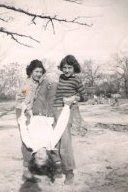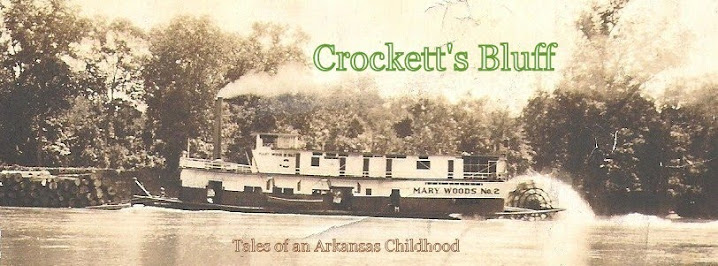I have Carol (Keithley) Baird to thank for the images below.
Like many "old" pictures, they were produced from cameras some of which would today be viewed as relatively "stone-aged" when compared with the stark clarity of images produced by even the most ordinary digital device today (even our cell phones). Gleaned from family albums and various shoe boxes of loose snapshots, they -- along with the stories that often lie behind them -- often provide us with essentially all we know of life in the Bluff during the 1920s and '30s, years when those of us "of a certain age" were youngsters not yet old enough to swim in the Prange canal.
Occasionally, they seem to startle the eye with their classic revelation of curiosity and levity -- evidence of the quality of life of those times, most notably the 1930s, in and around Crockett's Bluff.
Like the one of the five young ladies in "Remembering Hazel," the one below of four young men posing on a log is a perfect example: (L-R) Gus McDonald, Joseph Keithley, Russell Marrs, and his brother Herman.
Though the photographer is unknown to me, the image has all the qualities of a posed portrait: similar flat caps and hands similarly folded, they stare seriously and curiously and unsmilingly into the camera. [There's obviously much to be known about these figures. Russell Marrs, in the decade after his return from the service during World War II was a great influence and inspiration to me, and I'm working on his story for this site. I seem to recall that Gus McDonald lost a leg in that war.]
 |
| L-R: Edna Prange, Alice Keithley, May Bowermaster, and Rose Gosnell |
 | ||||
| Barbara Cochran, Ida Marilyn Butler, Donna Knowlton, Carol Keithley, Ann Johnson, and "probably Peggy Schwab." |
 |
| Yvonne Terry, Mary Lou Graves and Carol Keithley |
 | ||||
| Joe and Alice Keithley and Rose and George Gosnell (1950s or 60s?) |
These images were scanned from photos, some of which are perhaps seventy or more years old. Although there are ways of improving their clarity somewhat, some are of subjects too just too far away from the camera to survive enlargement. Other such images -- with or without the stories behind them -- are welcomed and appreciated for this site. As I have recently written to Carol Baird: "When folks like us become too senile to identify the subjects in such pictures, they die, along with the stories we know about them." Preventing such "deaths" is the primary purpose of this site. Once they are written down they have a fine chance at being passed along to future generations.

